warning lights CADILLAC DEVILLE 1993 7.G Owners Manual
[x] Cancel search | Manufacturer: CADILLAC, Model Year: 1993, Model line: DEVILLE, Model: CADILLAC DEVILLE 1993 7.GPages: 406, PDF Size: 20.78 MB
Page 17 of 406
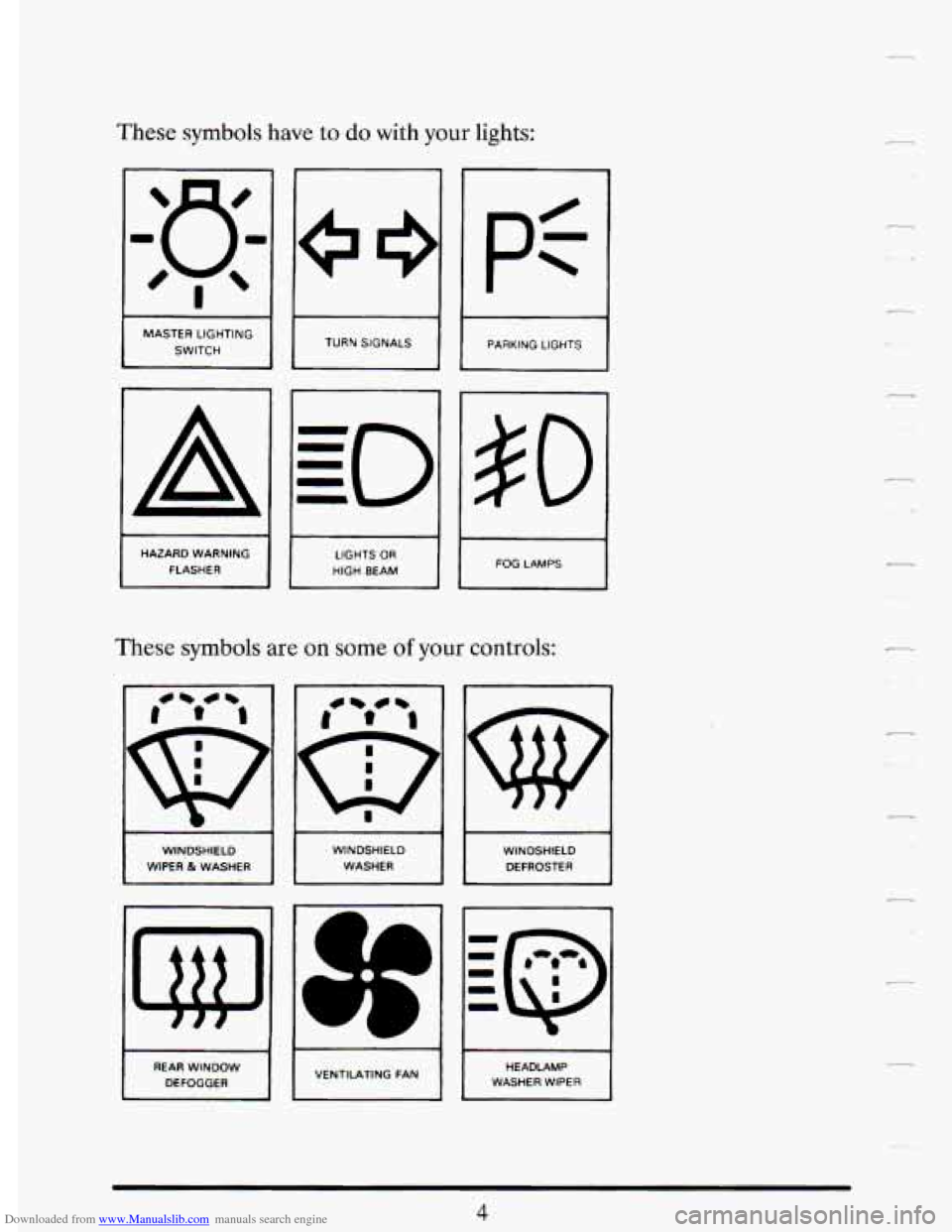
Downloaded from www.Manualslib.com manuals search engine These symbols have to do with your lights:
n
I
TURN SIGNALS
MASTER LIGHTING
SWITCH PARKING
LIGHTS
A $0 *. 1
1 FOG LAMPS I
HAZARD WARNING
FLASHER
~~
LIGHTS OR HIGH BEAM
These symbols are on some of your controls:
Q
WINDSHIELD WIPER & WASHER WINDSHIELD
WASHER WINDSHIELD
DEFROSTER
REAR WINDOW
DEFOGGER
- .~
HEADLAMP
WASHER WIPER
I VENTILATING FAN
Page 18 of 406
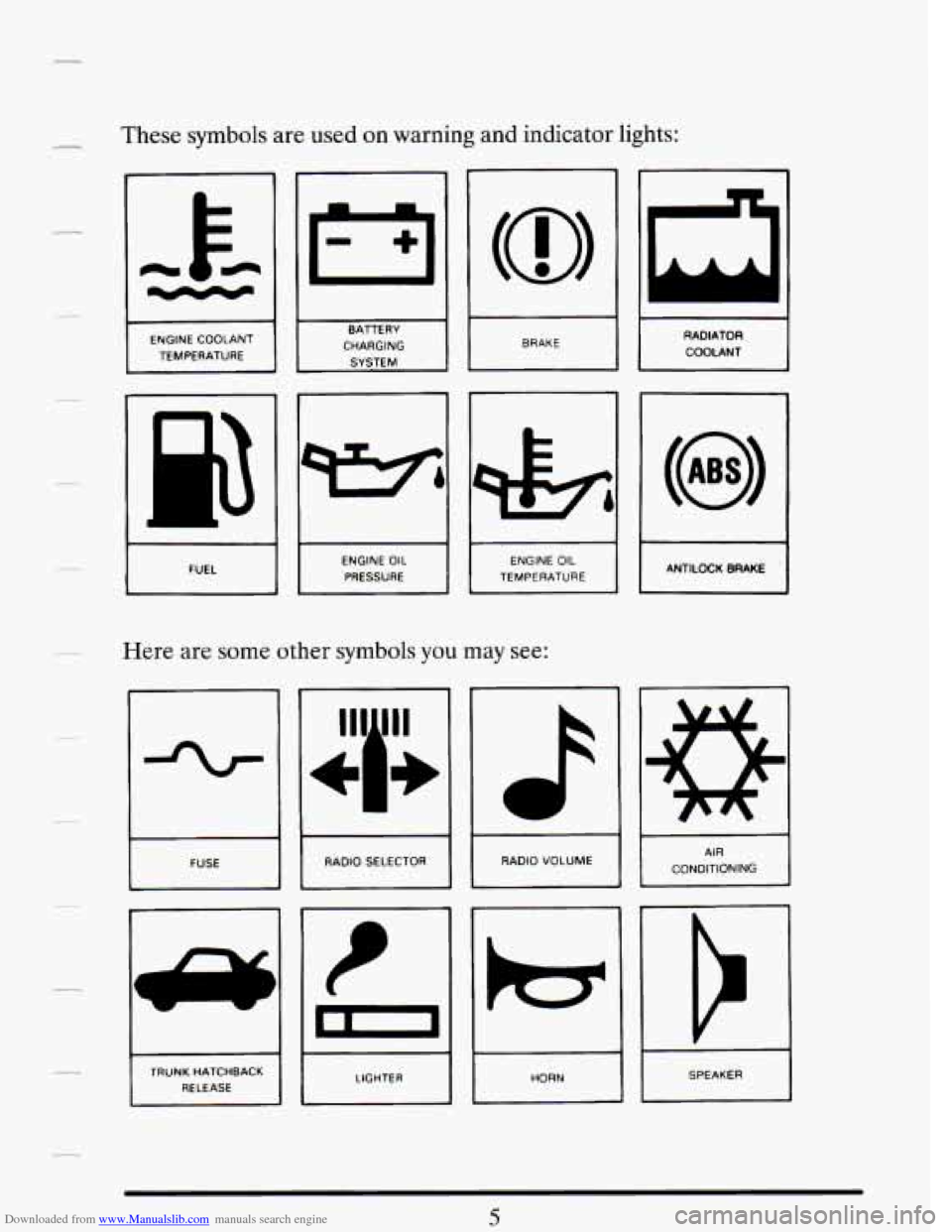
Downloaded from www.Manualslib.com manuals search engine These symbols are used on warning and indicator lights:
r3 BRAKE
ENGINE COOLANT
TEMPERATURE BAlTERY
CHARGING SYSTEM
93
U
ANTILOCK BRAKE I FUEL I ENGINE OIL
PRESSURE ENGINE OIL
TEMPERATURE
Here are some other symbols you may see:
U
RADIO VOLUME m RADIO SELECTOR E CONDITIONING
t
U
LIGHTER I SPEAKER TRUNK HATCHBACK
RELEASE
5
Page 118 of 406
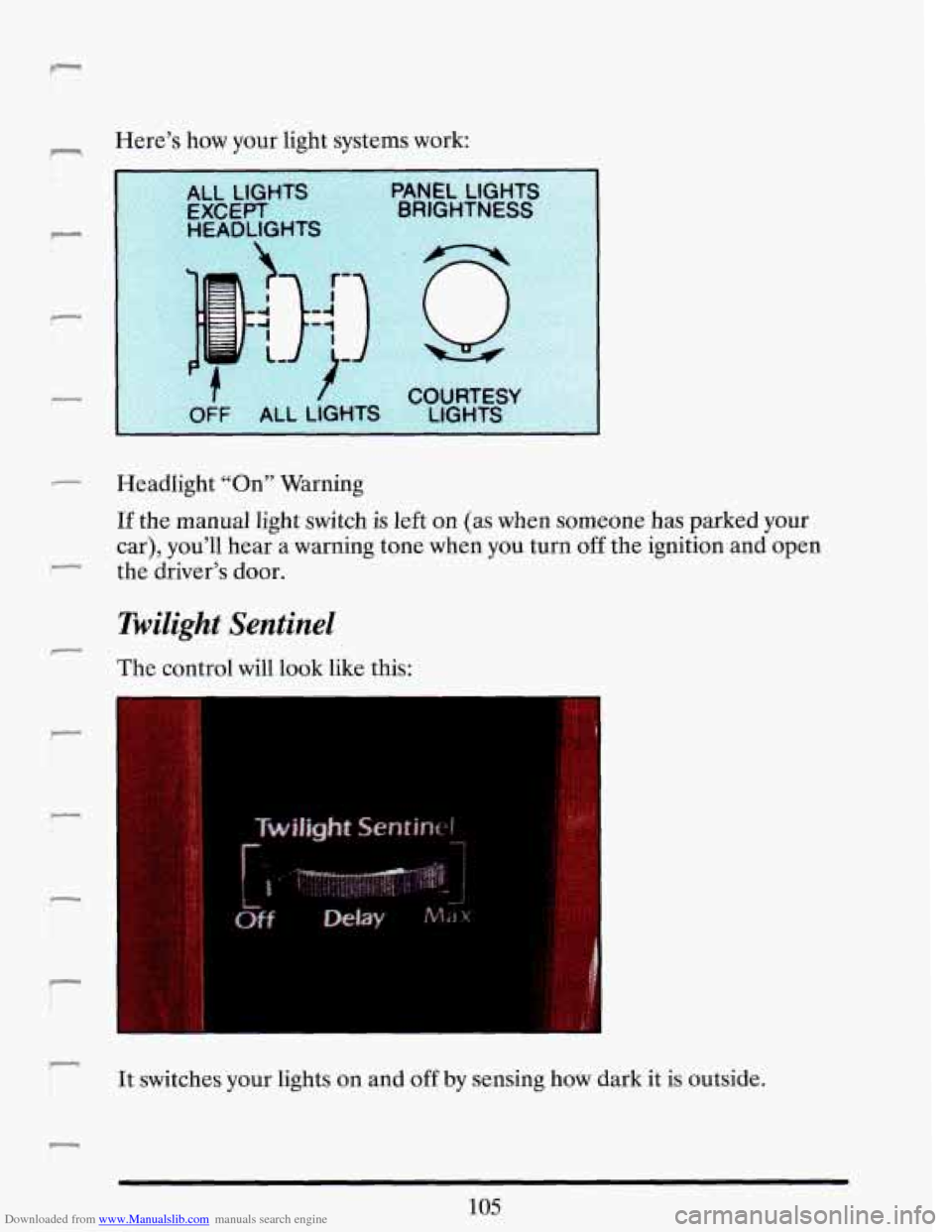
Downloaded from www.Manualslib.com manuals search engine r Here’s how your light systems work:
Headlight “On” Warning
If the manual light switch is left on (as when someone has parked your
car), you’ll hear a warning tone when you turn off the ignition and open
the driver’s door.
Twilight Sentinel
-
i.
I
The control will look like this:
r
It switches your lights on and off by sensing how dark it is outside.
105
Page 133 of 406

Downloaded from www.Manualslib.com manuals search engine Odometer
Your Cadillac has a “tamper-resistant odometer.” On the analog
odometer, if
you see silver lines between the numbers, probably someone
has tried to turn it back.
The numbers may not be true. If you have the
optional digital odometer, it will say
ERROR if someone has tampered
with it.
You may wonder what happens
if a car has to have a new odometer
installed. If possible, the new one
has to be set to the same reading the
old one had.
If it can’t be, then it’s set at zero, but a label on the driver’s
door must show the old reading and when the new one was installed.
WMING LIGHTS
This section describes the warning lights that are on your vehicle. The
pictures will help you locate them.
Warning lights can signal that something is wrong before it becomes
serious enough to cause an expensive repair or replacement. Paying
attention to your warning lights could also save you or others from injury.
Warning lights go on when there may be or is a problem with one
of your
vehicle’s functions.
As you will see in the details on the next few pages,
some warning lights come
on briefly when you turn the ignition key just to
let you know they’re working.
If you are familiar with this section, you
should not be alarmed when this happens.
c.
Page 134 of 406

Downloaded from www.Manualslib.com manuals search engine When one of the warning lights comes on and stays on when you are
driving, check the section that tells you what to do about it. Pkase
follow
the manual’s advice. Waiting to do repairs can be costly -- and even
dangerous.
So please get to know your warning lights. They’re a big help.
Brake System Warning Light
Your Cadillac’s hydraulic brake system is divided into two parts. If one
part isn’t working, the other part can still work and stop you. For good
braking, though,
you need both parts working well.
If the warning light goes on, there could be a brake problem. Have your
brake system inspected right away.
This light shoula
come
on and turn off as you
start the vehicle. If it
doesn’t come on then,
have it fixed
so it will
be ready to warn you
if
there’s a problem.
This light will also come on when you set your parking brake, and will
- stay on if your parking brake doesn’t release fully. If it stays on after your
parking brake is fully released, it means you have a brake problem. If the
light comes on while driving, pull
off the road and stop carefully. You may
-_ notice that the pedal is harder to push. Or, the pedal may go closer to the
floor. It may take longer to stop.
If the light is still on, have the vehicle
towed for service.
(See “Towing Your Vehicle” in the Index.)
121
Page 188 of 406
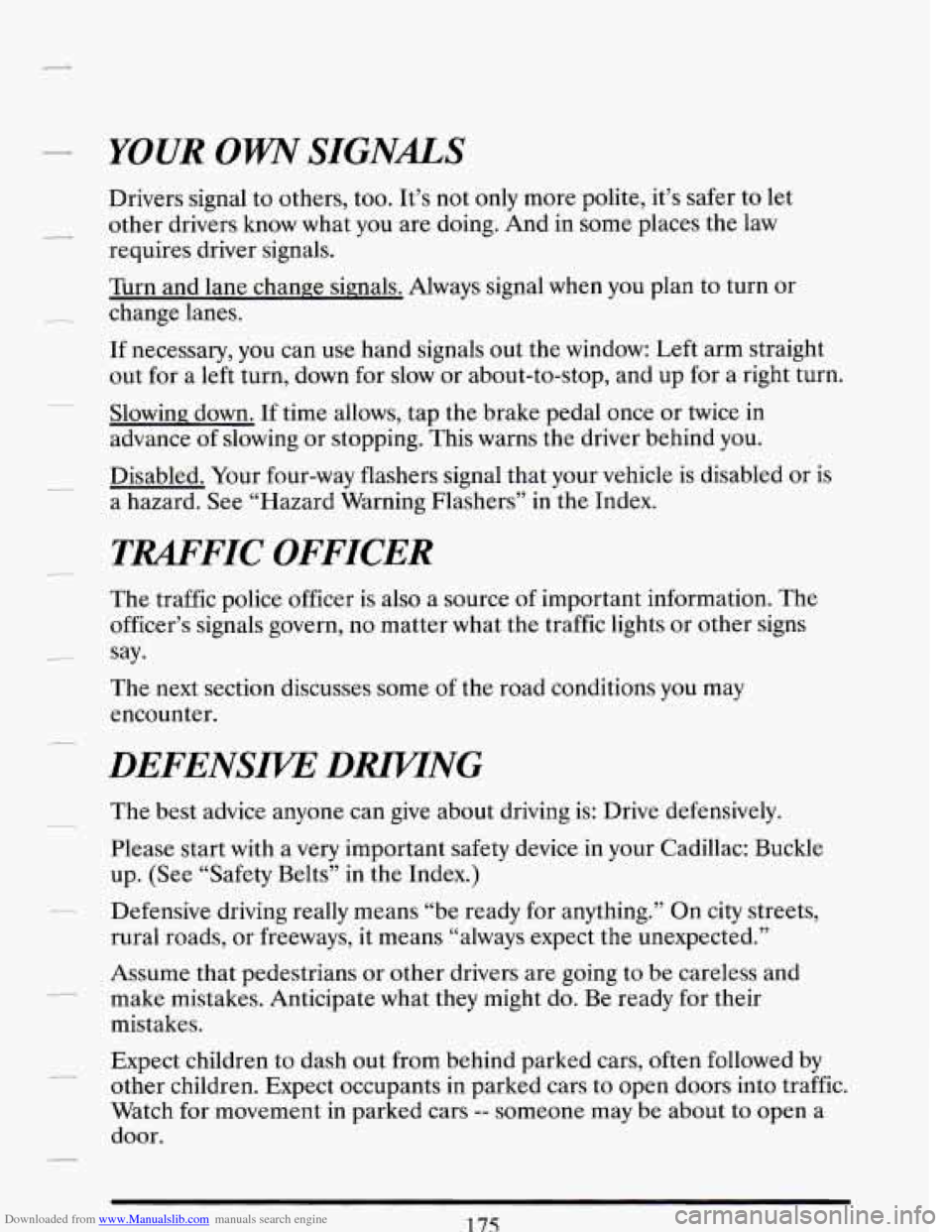
Downloaded from www.Manualslib.com manuals search engine - YOUR OWN SIGNALS
Drivers signal to others, too. It’s not only more polite, it’s safer to let
requires driver signals.
- other drivers know what you are doing. And in some places the law
Turn and lane change signals. Always signal when you plan to turn or
change lanes.
If necessary, you can use hand signals out the window: Left arm straight
out
for a left turn, down for slow or about-to-stop, and up for a right turn.
Slowing down. If time allows, tap the brake pedal once or twice
in
advance of slowing or stopping. This warns the driver behind you.
Disabled. Your four-way flashers signal that your vehicle
is disabled or is
a hazard. See “Hazard Warning Flashers” in the Index.
- TRAFFIC OFFICER
The traffic police officer is also a source of important information. The
officer’s signals govern, no matter what the traffic lights or other signs
say.
The next section discusses some of the road conditions you may
encounter.
DEFENSIKE DmNG
The best advice anyone can give about driving is: Drive defensively.
Please start with a very important safety device in your Cadillac: Buckle
up. (See “Safety Belts” in the Index.)
Defensive driving really means “be ready for anything.”
On city streets,
rural roads, or freeways, it means “always expect the unexpected.”
Assume that pedestrians or other drivers are going to be careless and
make mistakes. Anticipate what they might do. Be ready for their
mistakes.
Expect children to dash out from behind parked cars, often followed
by
other children. Expect occupants in parked cars to open doors into traffic.
Watch for movement in parked cars
-- someone may be about to open a
door.
175
~ -.
Page 213 of 406
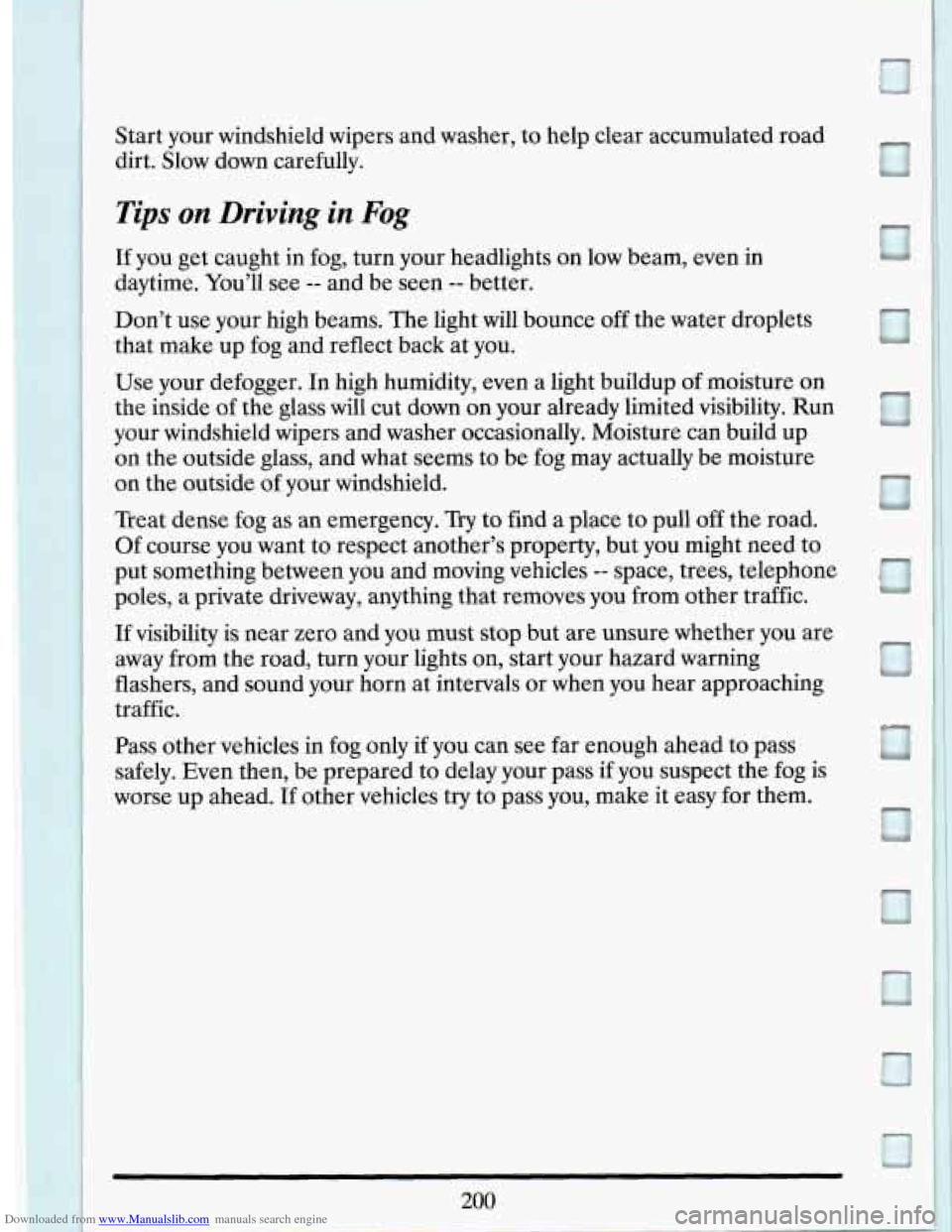
Downloaded from www.Manualslib.com manuals search engine I I
Start your windshield wipers and washer, to help clear accumulated road
dirt. Slow down carefully.
Tips on Driving in Fog
If you get caught in fog, turn your headlights on low beam, even in
daytime. You’ll see -- and be seen -- better.
Don’t use your high beams. The light will bounce off the water droplets
that make up fog and reflect back at you.
Use your defogger.
In high humidity, even a light buildup of moisture on
the inside
of the glass will cut down on your already limited visibility. Run
your windshield wipers and washer occasionally. Moisture can build up
on the outside glass, and what seems to be fog may actually be moisture
on the outside of your windshield.
Treat dense fog as an emergency.
Try to find a place to pull off the road.
Of course you want to respect another’s property, but you might need to
put something between you and moving vehicles
-- space, trees, telephone
poles, a private driveway, anything that removes you from other traffic.
If visibility is near zero and you must stop but are unsure whether you are
away from the road, turn your lights on, start your hazard warning
flashers, and sound your horn at intervals or when you hear approaching
traffic.
Pass other vehicles in fog only if you can see far enough ahead to pass
safely. Even then, be prepared to delay your pass if you suspect the fog is
worse up ahead.
If other vehicles try to pass you, make it easy for them.
Page 217 of 406
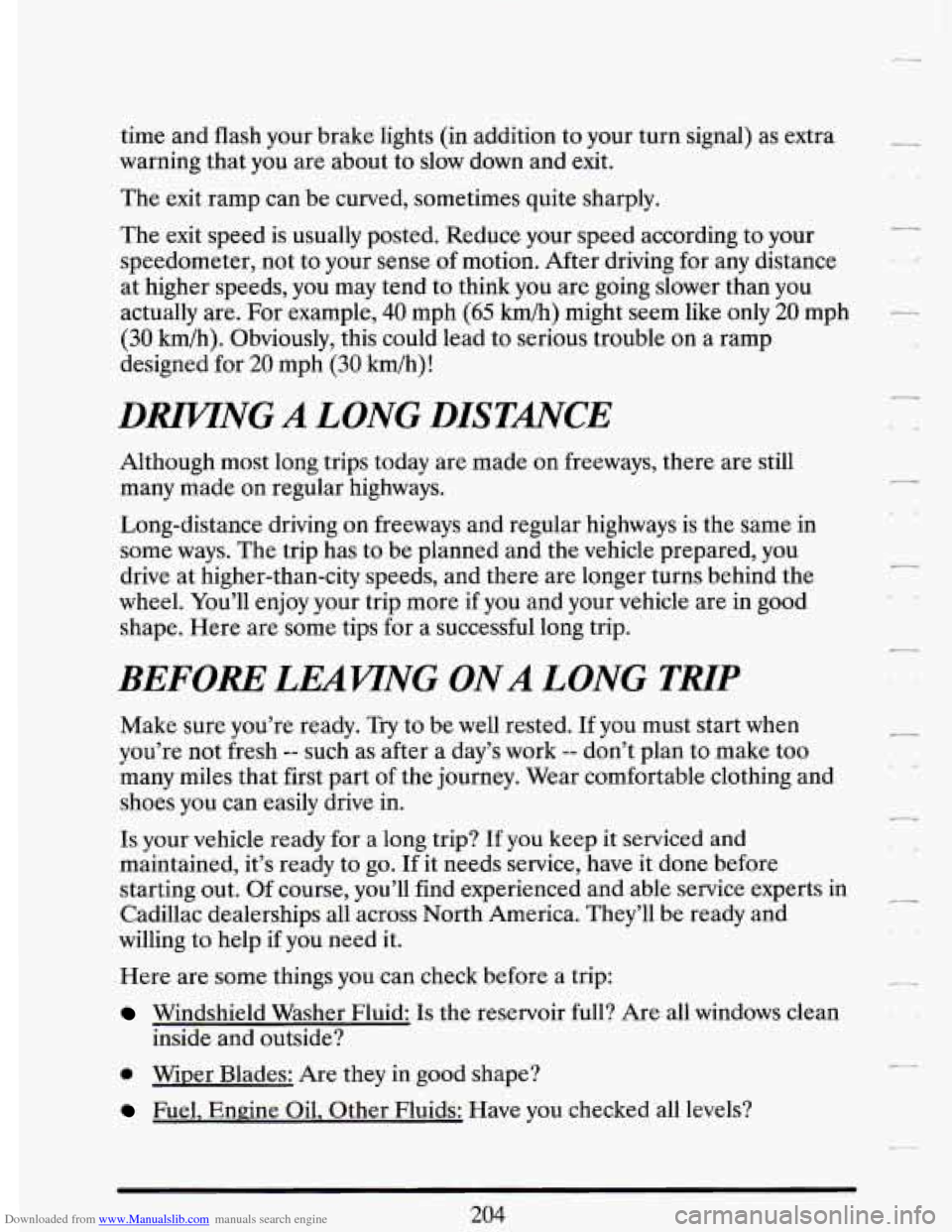
Downloaded from www.Manualslib.com manuals search engine time and flash your brake lights (in addition to your turn signal) as extra
warning that you are about to slow down and exit.
The exit ramp can be curved, sometimes quite sharply.
The exit speed is usually posted. Reduce your speed according to your
speedometer, not to your sense
of motion. After driving for any distance
at higher speeds,
you may tend to think you are going slower than you
actually are. For example,
40 mph (65 kmh) might seem like only 20 mph
(30 krn/h). Obviously, this could lead to serious trouble on a ramp
designed
for 20 mph (30 km/h)!
DmNG A LONG DISTANCE
Although most long trips today are made on freeways, there are still
many made
on regular highways.
Long-distance driving on freeways and regular highways is the same in
some ways. The trip has to be planned and the vehicle prepared, you
drive at higher-than-city speeds, and there are longer turns behind the
wheel. You’ll enjoy your trip more if you and your vehicle are in good
shape. Here are some tips for a successful long trip.
BEFORE LEAWNG ONA LONG TMP
Make sure you’re ready. Try to be well rested. If you must start when
you’re not fresh
-- such as after a day’s work -- don’t plan to make too
many miles that first part of the journey. Wear comfortable clothing and
shoes you can easily drive in.
Is your vehicle ready for a long trip? If you keep it serviced and
maintained, it’s ready to go. If it needs service, have it done before
starting out.
Of course, you’ll find experienced and able service experts in
Cadillac dealerships all across North America. They’ll be ready and
willing to help if you need it.
Here are some things you can check before a trip:
Windshield Washer Fluid: Is the reservoir full? Are all windows clean
inside and outside?
0 Wiper Blades: Are they in good shape?
Fuel, Engine Oil, Other Fluids: Have you checked all levels?
c
204
Page 235 of 406
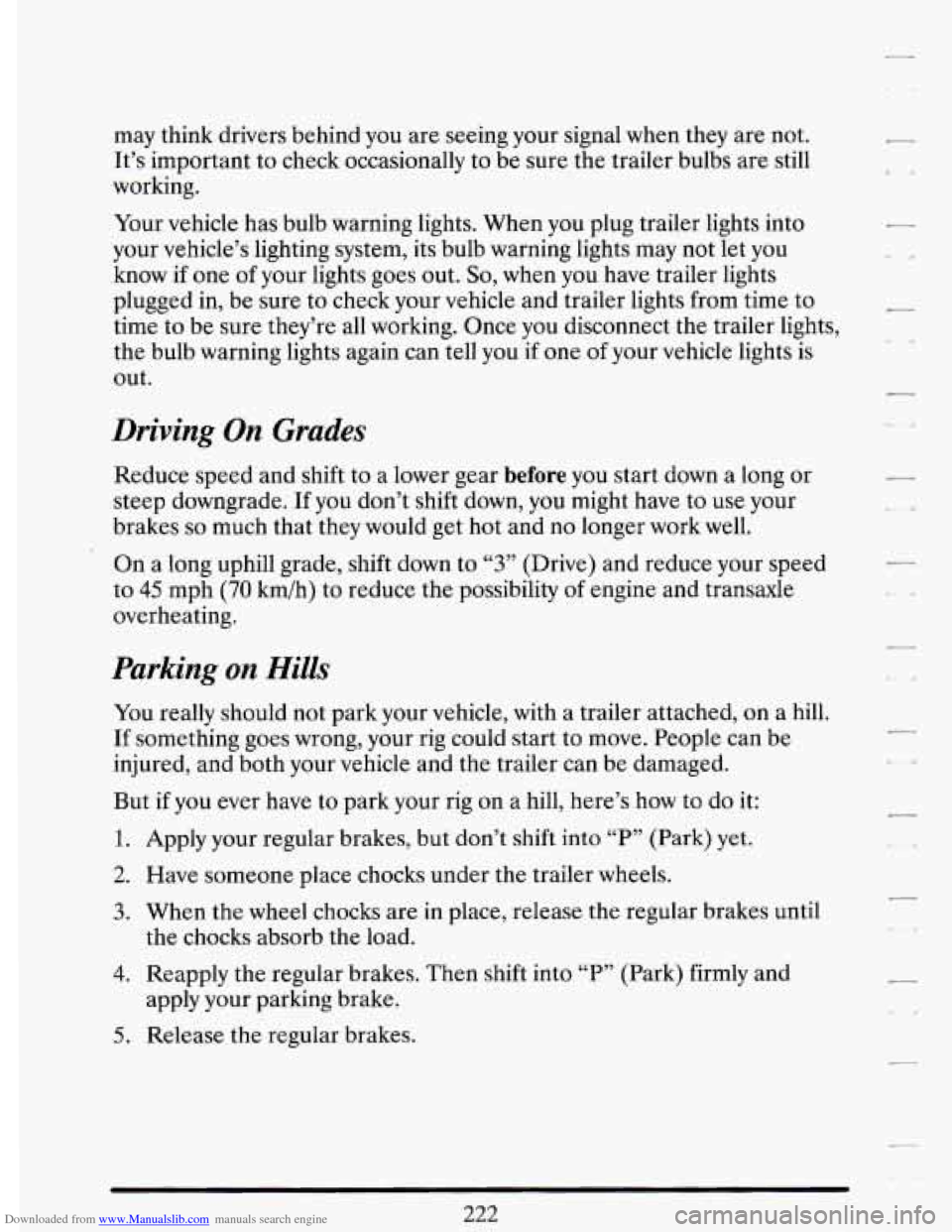
Downloaded from www.Manualslib.com manuals search engine may think drivers behind you are seeing your signal when they are not.
It’s important to check occasionally to be sure the trailer bulbs are still
working.
Your vehicle has bulb warning lights. When you plug trailer lights into
your vehicle’s lighting system, its bulb warning lights may not let you
know if one
of your lights goes out. So, when you have trailer lights
plugged in, be sure to check your vehicle and trailer lights
from time to
time to be sure they’re all working. Once you disconnect the trailer lights,
the bulb warning lights again can tell you if one of your vehicle lights is
out.
Driving On Grades
Reduce speed and shift to a lower gear before you start down a long or
steep downgrade.
If you don’t shift down, you might have to use your
brakes
so much that they would get hot and no longer work well.
On a long uphill grade, shift down to “3” (Drive) and reduce your speed
to
45 mph (70 km/h) to reduce the possibility of engine and transaxle
overheating.
Parking on Hills
You really should not park your vehicle, with a trailer attached, on a hill.
If something goes wrong, your rig could start to move. People can be
injured, and both your vehicle and the trailer can be damaged.
But if you ever have to park your rig on a hill, here’s how to do it:
1. Apply your regular brakes, but don’t shift into “P” (Park) yet.
2. Have someone place chocks under the trailer wheels.
3. When the wheel chocks are in place, release the regular brakes until
the chocks absorb the load.
4. Reapply the regular brakes. Then shift into “P” (Park) firmly and
apply your parking brake.
5. Release the regular brakes.
222
Page 238 of 406

Downloaded from www.Manualslib.com manuals search engine _HAZARD WMING FLASHERS
'/
..
Your hazard warning flashers let you warn others. They also let police
know you have a problem. Your front and rear turn signal lights will flash
on and
off.
Press the button in to
make your front and
rear turn signal lights
flash on and
off.
I
Your hazard warning flashers work no matter what position your key is in,
and even if the key isn't in.